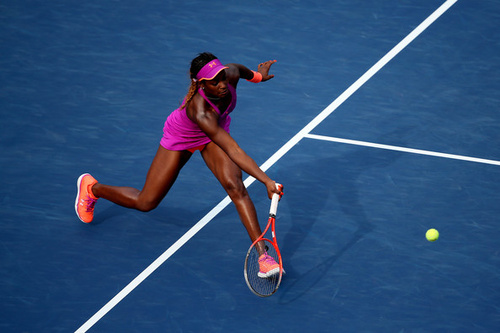Don't miss any stories → Follow Tennis View
FollowHow Paul Annacone Can Boost Sloane Stephens
Sloane Stephens, currently ranked 12th on the WTA Tour, has hired Roger Federer’s most recent coach, Paul Annacone, on an experimental basis. This move comes after Stephens split up with David Nainkin, who worked with her for the entirety of 2013. At the moment, there are no far-reaching plans for this relationship beyond the current offseason.
This partnership may come as a surprise considering Annacone has only teamed up with ATP players in the past. Before Federer, Annacone worked with Pete Sampras and Tim Henman.
While some may be skeptical of an exclusively ATP player/coach taking the role of head coach for a WTA player, it is important to remember that tennis is still tennis regardless of gender. Annacone will not have to introduce any drastic alterations in his coaching philosophy and methods now that he is working with a woman. While Sloane Stephens is obviously not Roger Federer or Pete Sampras, Annacone is still teaching the game of tennis. His advice for Federer and Stephens will certainly not be entirely congruent with each other, but there are fundamental aspects of the game that Annacone can instill in Stephens that are valuable to most tennis players.
So what exactly will Annacone have in store for Stephens?

For one, look for Annacone to make Stephens more versatile. It is simple enough: if a player can dominate and end points from the baseline and also dominate and end points at the net, why not do both? Currently, Stephens has started to resemble many of the top male American players. She has a booming serve and massive groundstrokes and loves to dictate particularly with her forehand. Those strengths can get her only so far. For example, Serena Williams is almost unplayable off her serve and from the baseline. But opponents who bring her forward find that her net skills pose a major obstacle because they are as impressive as the other aspects of her game.
Paul Annacone was an accomplished player in his own right. In singles, he reached the third round of every major and was a Wimbledon quarterfinalist in 1984. In doubles, Annacone’s accomplishments were much more significant. He won the Australian Open doubles title in 1985 and reached the US Open doubles final five years later.
With this in mind, it is evident that Annacone, who served and volleyed in singles and doubles, has bountiful knowledge on the art of moving forward. He surely will teach that art to Stephens. Whether it be chipping and charging, serving and volleying, or simply moving forward on short balls, expect Sloane Stephens to increase her net presence in 2014.
The other aspect of Stephen’s game that Annacone may be hoping to improve is Stephen’s elongated swing on her groundstrokes. The young American certainly packs a powerful punch, but she does so with lengthy, windmill-type strokes. On faster, lower-bouncing surfaces, particularly grass, these groundstrokes become much harder to effectively produce on a consistent basis. Annacone is an old-timer, a hardened traditionalist. Nevertheless, the games of the players whom he has coached all have been predicated on simple, compact, and technically sound groundstrokes. Moving forward, look for Annacone to possibly shorten up Stephen’s swings to help her handle the pace of the WTA’s heavy hitters on fast surfaces.
In 2013, Stephens made the Australian Open semifinals, French Open fourth round, Wimbledon quarterfinals, and the US Open fourth round. She also recorded wins over Serena Williams and Maria Sharapova. For Stephens, the sky is the limit, and Paul Annacone may be the missing piece to help her get there.










